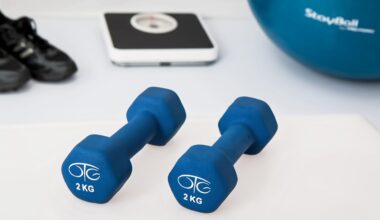How to Track Your Walking Progress for Better Results
Tracking your walking progress is essential for achieving weight loss goals. Knowing your starting point enables you to establish clear, measurable goals. Start by getting a reliable method to monitor your distance. You can use a fitness tracker or smartphone app that records your daily mileage. Make sure to choose one that is user-friendly and reliable. Maintaining a journal can also help track your daily walks. Write down the duration, distance, and how you felt afterward. This added insight can help you push through tough days and celebrate the progress made.
It’s also beneficial to take measurements for a more comprehensive view of your progress. Consider taking body measurements such as waist, hips, and thighs. Recording these numbers can provide motivation as they begin to change. Another useful tracking method involves recording the number of steps taken. Aim for 10,000 steps a day and gradually increase your goal. You can track your steps using an app or traditional pedometer. Set weekly targets to keep pushing yourself while monitoring those goals regularly.
Using Technology to Enhance Tracking
Utilizing technology can significantly enhance how you track your walking. Consider downloading fitness apps that specialize in walking. These apps often come with features that allow you to set goals, share progress, and even compete with friends. Some apps can integrate with wearable devices, providing more accurate data. Keeping track of your calorie expenditure can be insightful too, as it can motivate you to maintain your routine. Ensure that you regularly input data for accurate tracking and insights.
In addition, GPS-enabled devices can help track the routes you walk. Use these tools to find new paths that may enhance your walking experience. Exploring new areas can keep your routine fresh and more enjoyable. Some platforms even allow you to engage in social aspects by inviting friends to join you on walking challenges. Challenge yourselves to cover longer distances or have competitions based on step counts. Incorporating social activities into your walking regime can create a sense of community.
Setting Realistic Goals
Setting realistic goals is crucial for maintaining motivation over time. Start by breaking your long-term weight loss goals into smaller, manageable steps. This approach helps you see progress sooner, fostering motivation. An example might be to gradually increase the duration of your walks, aiming for an additional five minutes each week. Remember that quality matters more than quantity in your walking sessions. Focus on achieving an efficient walk rather than solely pushing for distance.
Moreover, it can be helpful to celebrate small victories along the way. Reward yourself for progress made, such as completing a month of consistent walking. Consider small treats that are mindful of your weight loss journey. You might enjoy a new workout outfit or book. This can help maintain your enthusiasm and commitment to your walking routine. Practicing mindfulness during your walks can also enhance the experience. Take time to appreciate the beauty around you, allowing a sense of peace during the activity.
Reviewing and Adjusting Your Progress
Periodically reviewing your progress is essential in any weight loss strategy. Schedule time weekly to assess your walking accomplishments and set new goals as necessary. Reflecting on your experiences may provide useful insights into what works versus what needs to change. Remember, some weeks may be better than others, and that’s completely fine. Ensure that you adjust your walking schedule and goals based on what you realistically can achieve, leading to more sustainable results.
Finally, tracking your walking can be fun if you incorporate variety into your routine. Try to introduce intervals where you walk fast for a few minutes followed by recovery periods. Alternate between different terrains or include scenic paths to keep your experience engaging. Participating in local walking groups can also enhance your routine and offer support. Sharing your experiences with others may provide new encouragement, making your walks more enjoyable while still effective for weight loss.


